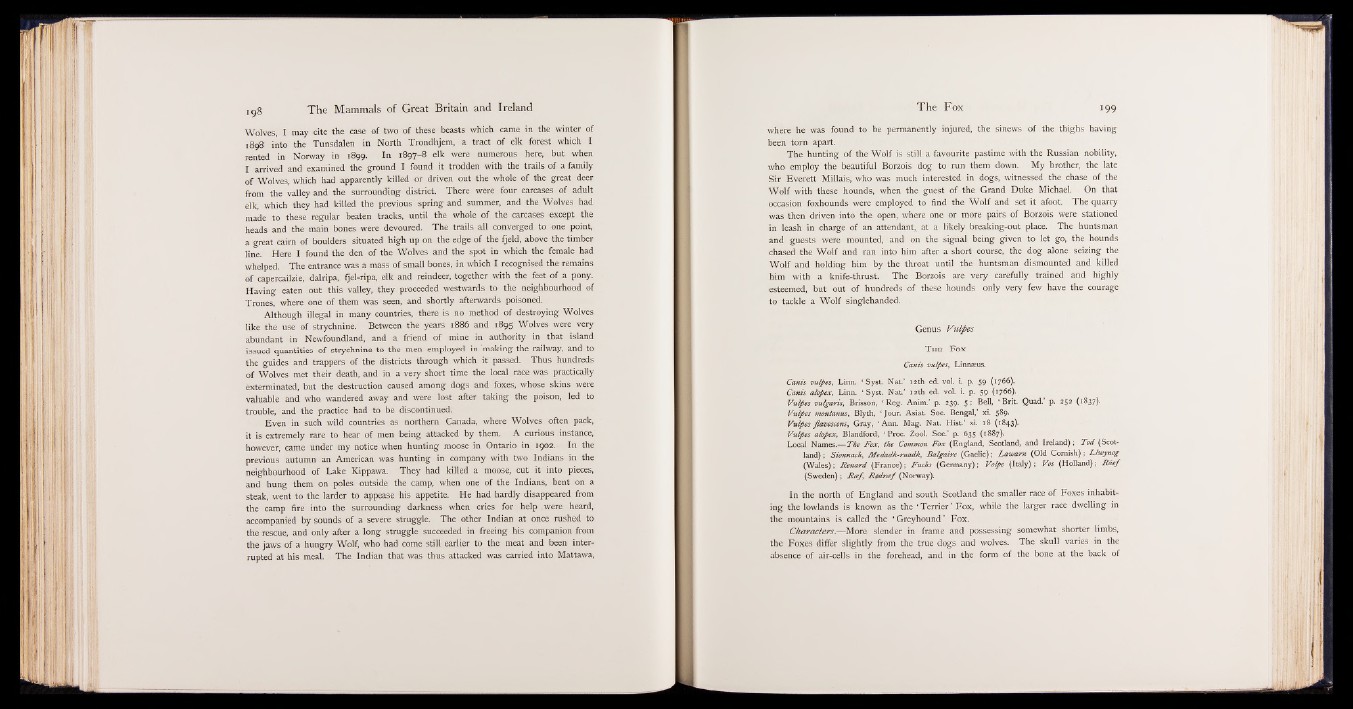
Wolves, I may cite the case of two of these beasts which came in the winter of
1898 into the Tunsdalen in North Trondhjem, a tract of elk forest which I
rented in Norway in 1899. In 1897-8 elk were numerous here, but when
I arrived and examined the ground I found it: trodden with the trails of a family
of Wolves, which had apparently killed or driven out the whole of the great deer
from the valley and the surrounding district. There were four carcases of adult
elk, which they had killed the previous spring and summer, and the Wolves had
made to these regular beaten tracks, until the whole of .the carcases except the
heads and the main bones were devoured. The trails all converged to one point,
a great cairn of boulders situated high up on the edge of the fjeld, above the timber
line. Here I found the den of the Wolves and the spot in which the female had
whelped. The entrance was a mass of small bones, in which I recognised the remains
of capercailzie, dalripa, fjel-ripa, elk and reindeer, together with the feet of a pony*
Having eaten out this valley, they proceeded westwards to the neighbourhood of
Trones, where one of them was seen, and shortly afterwards poisoned.
Although illegal in many countries, there is no method of destroying Wolves
like the use of strychnine. Between the years 1886 and 1895 Wolves were very
abundant in Newfoundland, and a friend of mine in authority in that island
issued quantities of strychnine to the men employed in making the railway, and to
the guides and trappers of the districts through which it passed. Thus, hundreds
of Wolves met their death, and in a very short time the local race was practically
exterminated, but the destruction caused among dogs and foxes, whose skins Were
valuable and who wandered away and were lost after taking the poison, led to
trouble, and the practice had to be discontinued.
Even in such wild countries as northern Canada, where Wolves often pack,
it isSextremely rare to hear of men being attacked by them. A curious instance,
however, came under my notice when hunting moose in Ontario in 1902. In the
previous autumn an American was hunting in company with two Indians in the
neighbourhood of Lake Kippawa. They had killed a moose, cut .it into pieces,
and hung them on poles outside the camp, when one of the Indians, bent on a
steak, went to the larder to appease his appetite. He had hardly disappeared from
the camp fire into the surrounding darkness when cries for help .were heard,
accompanied by sounds of a severe struggle. The other Indian at once rushed to
the rescue, and only after a long struggle succeeded in freeing his companion from
the jaws of a hungry Wolf, who had come still earlier to the meat and been interrupted
at his meal. The Indian that was thus attacked .was carried into Mattawa,
where he was found to be permanently injured, the sinews of the thighs having
been torn apart.
The hunting of the Wolf is still a favourite pastime with the Russian nobility,
who employ the beautiful Borzois dog to run them down. My brother, the late
Sir Everett Millais, who was much interested in dogs, witnessed, the chase of the
Wolf with these hounds, when the guest of the Grand Duke Michael. On that
occasion foxhounds were employed to find the Wolf: and set it afoot. The quarry
was then driven into the open, where onevqfemore pairs of Borzois were stationed
in leash in charge of an attendant, at a likely breaking-out place. The huntsman
and guests were mounted, and on the signal being given to let go, the hounds
chased the Wolf and ran intcwhfm after a short, course, the dog alone seizing the
Wolf and holding him by the throat until the huntsman dismounted and killed
him with a knife-thrust. The Borzois are very carefully trained and highly
esteemed, but out of hundreds i f these hounds '’duly very few have the courage
to tackle a Wolf singlehanded.
Genus Vulpes
T h e F o x
Canis vulpes, Linnaeus.
Canis vulpes, Linn. ‘ Syst. Nat.’ 12th ed. vol. i. p. 59 (1766).
Canis alopex, Linn. ‘ Syst. Nat.’ 12th ed. vol. i. p. 59 (I7^6).
Vulpes vulgaris, Brisson, ‘ Reg. Anim.’ p. 239. 5; Bell, ‘ Brit. Quad.’ p. 252 (1837).
Vulpes montanus, Blyth, ‘ Jour. Asiat. Soc. Bengal,’ xi. 589.
Vulpes flavescens, Gray, ‘ Ann. Mag. Nat. Hist’ xi. 18 (1843).
Vulpes alopex, Blandford, ‘ Proc. Zool. Soc.’ p. 635 (1887).
Local Names.— The F ox, the Common F o x (England, Scotland, and Ireland); Tod (Scotland)
; Sionnach, Medadk-ruadh, Balgaire (Gaelic); Lawa,m (Old Cornish); Llwynog
(Wales); Renard (France); Fuchs (Germany); Volpe (Italy); Vos (Holland); R d ef
(Sweden) ; Reef, R fd rcef (Norway).
In the north of England and south Scotland the smaller race of Foxes inhabiting
the lowlands is known as the ‘ Terrier’ Fox, while the larger race dwelling in
the mountains is called the ‘ Greyhound’ Fox.
Characters.— More slender in frame and possessing somewhat shorter limbs,
the Foxes differ slightly from the true dogs and wolves. The skull varies in the
absence of air-cells in the forehead, and in the form of the bone at the back of